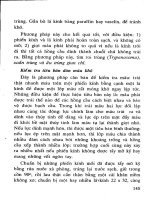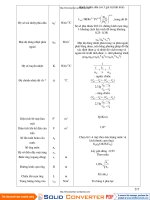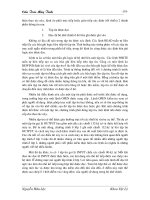.Ocean Modelling for Beginners Phần 10 potx
Bạn đang xem bản rút gọn của tài liệu. Xem và tải ngay bản đầy đủ của tài liệu tại đây (803.91 KB, 14 trang )
160 6 Rotational Effects
Fig. 6.26 Exercise 21. Shape of the density interface after 10 days of simulation
Fig. 6.27 Exercise 21. Currents (arrows, averaged over 2×2 grid cells) and Eulerian tracer concen-
tration (contours) in the top layer after 10 and 12.5 days of simulation. Cross-frontal fl w attains
speeds of 50 cm/s
of this instability, the front starts to meander forming alternating zones of positive
and negative relative vorticity (Fig. 6.27). Baroclinic eddies appear soon after this
mixing whereby cyclonic eddies remain centered along the axis of the front while
anticyclonic eddies are moved away from the frontal axis. The diameter of eddies
6.15 Exercise 21: Frontal Instability 161
Fig. 6.28 Exercise 21. Currents (arrows, averaged over 2×2 grid cells) and pressure anomalies
(solid contours emphasise low pressure centres) in the bottom layer after 10 and 17 days of simu-
lation. Deep cyclones attain maximum f ow speeds of 20 cm/s
is 10–20 km. Later in the simulation (not shown), eddies interact with each other
and produce vigorous lateral mixing in the entire model domain. Surface eddies are
associated with swift currents of speeds exceeding 50 cm/s.
Bottom currents of noticeable speed (benthic storms) start to develop from day
10 of the simulation onward and approach values of >20 cm/s by the end of the
simulation (Fig. 6.28). Interestingly, the structure of disturbances in the bottom layer
is different from those in the upper layer. Here it is exclusively the cyclonic eddies
that trigger the growth of instabilities. This process leading to the preferred creation
of cyclonic eddies is called cyclogenesis.
6.15.4 Sample Code and Animation Script
The folder “Exercise 21” of the CD-ROM contains the computer codes for this
exercise. The “info.txt” fil gives more information.
162 6 Rotational Effects
6.15.5 Additional Exercise for the Reader
Repeat this exercise for an ocean uniform in density (ρ
1
= ρ
2
= 1028 kg m
−3
)to
explore whether the barotropic instability process alone can produce a similar form
of frontal instability. The two-layer version of the shallow-water equations can be
adopted for this task, but the reader should avoid division by zero. . .
6.16 Density-Driven Flows
6.16.1 Background
Density-driven f ows are bodies of dense water that cascade downward on the con-
tinental slope to a depth where they meet ambient water of the same density. At
this equilibrium density level, these f ows tend to fl w along topographic contours
of the continental slope. Detachment from the seafloo and injection into the ambi-
ent ocean is also possible. Numerical modelling of gravity plumes started with the
“streamtube model” of Smith (1975). This model considers a laterally integrated
streamtube with a variable cross-sectional area and, under the assumption of sta-
tionarity, it produces the path and laterally averaged properties (density contrast,
velocity) of the plume on a given slope.
With an advanced method describing the dynamics of such reduced-gravity
plumes, Jungclaus and Backhaus (1994) employed the shallow-water equations for
a two-layer flui with an upper layer at rest. Without exchange of flui across the
“skin” of the plume, the dynamic governing this model can be written as:
∂u
2
∂t
+u
2
∂u
2
∂x
+v
2
∂u
2
∂y
− f v
2
=−g
∂η
2
∂x
−
τ
bot
x
h
2
ρ
2
∂v
2
∂t
+u
2
∂v
2
∂x
+v
2
∂v
2
∂y
+ fu
2
=−g
∂η
2
∂y
−
τ
bot
y
h
2
ρ
2
(6.72)
∂η
2
∂t
+
∂(u
2
h
2
)
∂x
+
∂(v
2
h
2
)
∂y
= 0
where g
= (ρ
2
− ρ
1
)/ρ
2
g is reduced gravity, and (τ
bot
x
,τ
bot
y
) represents the fric-
tional stress at the seafloo . These equations are known as the reduced-gravity plume
model. Interface displacements η
2
are define with respect to a certain reference
level. When formulated in finit differences, the CFL stability criterion in such a
model is given by:
Δt ≤
min(Δx, Δy)
√
2g
h
max
where h
max
is maximum plume thickness.
6.17 Exercise 22: Reduced-Gravity Plumes 163
Fig. 6.29 Definitio of interface displacement and layer thickness for the reduced-gravity plume
model
For simplicity, we assume that the plume is denser than any ambient water, so
that the deepest part of the model domain can be chosen as reference level. The tilt
of the surface of the plume is then calculated with reference to this level (Fig. 6.29).
This implies that with initial absence of a plume, interface displacements η
2,o
have
to follow the shape of the bathymetry. This is similar to treatment of sloping coasts
in the floodin algorithm (see Sect. 4.4).
6.17 Exercise 22: Reduced-Gravity Plumes
6.17.1 Aim
The aim of this exercise is to explore the dynamics inherent with the descent of a
reduced-gravity plume on a sloping seafloo .
6.17.2 Task Description
We consider a model domain of 200 km in length and 100 km in width (Fig. 6.30),
resolved by lateral grid spacings of Δx = Δy = 2 km. The seafloo has a mild uni-
form upward slope of 200 m per 100 km in the y-direction. Since the surface ocean
is at rest in this reduced-gravity plume model, the total water depth is irrelevant
here. Frictional stresses at the seafloo are described by a quadratic bottom-friction
law.
An artificia coastline is placed along the shallow side of the model domain,
except for a narrow opening of 6 km in width used as a source for the reduced-
gravity plume to enter the model domain. The initial thickness of the plume is set to
100 m in this opening. The density excess of the plume is set to 0.5 kg m
−3
. Density
of ambient water is ρ
1
= 1027 kg m
−3
. Zero-gradient conditions are used at open
boundaries for all variables.
164 6 Rotational Effects
Fig. 6.30 Bathymetry for Exercise 22 (Scenario 2)
Two different scenarios are considered. The Coriolis force is ignored in the f rst
scenario. Case studies consider variations of bottom drag coefficient The total sim-
ulation time is one day with data outputs at every hour. Because we expect a sym-
metric shape of the plume, the forcing region is placed in the centre of the otherwise
closed boundary that cuts along shallower regions of the model domain.
The second scenario includes the Coriolis force with f =+1×10
−4
s
−1
(northern
hemisphere). Again, case studies consider variations of values of the bottom-drag
coefficient The total simulation time is 5 days with one-hourly data outputs. In
anticipation of rotational effects imposed by the Coriolis force, the forcing region is
moved some distance. This is why the forcing region has been moved some distance
upstream, as is shown in Fig. 6.30. The time step is set to Δt = 6 s in all experiments.
6.17.3 Write a New Simulation Code?
There is no need to formulate a new FORTRAN simulation code for this exercise.
Instead, the two-layer of this, the two-layer version of the shallow-water equations,
used in Exercises 20 and 21, can be applied with the constraint that the surface layer
is at rest.
6.17.4 Results
As anticipated, the forcing applied creates a gravity current moving denser water
away from the source. First, we consider the situation without the Coriolis force
(Scenario 1). On an even seafloo , the spreading of dense water would be radially
symmetric. On the other hand, a sloping seafloo supports a net downslope pressure-
gradient force, so that, in addition to radial spreading, the plume moves downslope
6.17 Exercise 22: Reduced-Gravity Plumes 165
Fig. 6.31 Exercise 22. Scenario 1. Snapshots of the horizontal distribution of plume thickness
(shading) for different values of the bottom-friction parameter r . The range shown is h
2
=0(black
shading)toh
2
=50m(white shading). Superimposed are horizontal fl w vectors (arrows,averaged
over 5×5 grid cells) and contours of η
2
(Fig. 6.31). A distinctive plume head develops for relatively small values of bottom
friction. This plume head is the result of the rapid gravitational adjustment taking
place during the initial phase of the simulation. Increased values of the bottom-
friction parameter lead to both disappearance of the plume head and overall weaker
fl ws.
The dynamical behaviour of reduced-gravity plumes is turned “upside down”
with inclusion of the Coriolis force. With relatively low levels of bottom fric-
tion, the plume rather follows bathymetric contours with only little tendency of
downslope motion (Fig. 6.32). With presence of the Coriolis force, it is increased
levels of bottom friction that induce an enhanced angle of downslope motion. Con-
sideration of simple steady-state dynamical balances between the reduced-gravity
force, the Coriolis force and the frictional force explains this interesting feature
(Fig. 6.33).
166 6 Rotational Effects
Fig. 6.32 Same as Fig. 6.31, but for Scenario 2
Fig. 6.33 Steady-state force balances of reduced-gravity plumes for various levels of bottom fric-
tion on the northern hemisphere. The reduced-gravity force (RGF) acts downward on the sloping
seafloo . The Coriolis force (CF) acts at a right angle with respect to the f ow direction. Bottom
friction (BF) acts opposite to the fl w direction
6.17.5 Sample Code and Animation Script
The folder “Exercise 22” of the CD-ROM contains the computer codes for this
exercise. See the f le “info.txt” for more information.
6.18 Technical Information 167
6.17.6 Additional Exercise for the Reader
Add a topographic obstacle such as a seamount or a seafloo depression to the
bathymetry and explore how reduced-gravity plumes deal with irregular bathymetry.
6.18 Technical Information
This book has been written in L
A
T
E
X using TeXnicCenter, downloadable at
/>in conjunction with MikTeX (Version 2.5) – a L
A
T
E
X implementation for the Win-
dows platform, which can be downloaded at:
/>Most graphs of this book were created with SciLab. GIMP has been used for
the manipulation of some images. GIMP is a cost-free alternative to commercial
graphical manipulation programs such as Adobe Photoshop. This software is freely
downloadable at:
/>Most sketches were made in Microsoft Word. Figure 3.21 was produced with
BLENDER (Version 2.43) – a three-dimensional animation suite (and game engine)
available at:
/>Bibliography
Arakawa, A., and Lamb, V., 1977: Computational design of the basic dynamical processes
of the ucla general circulation model, in Methods in Computational Physics, vol. 17, pp.
174–267. Academic Press London.
Boussinesq, J., 1903: Th
´
eorie Analytique de la Chaleur. Vol. 2. Gautier Villars, Paris.
Brunt, D., 1927: The period of simple vertical oscillations in the atmosphere. Q. J. R. Met. Soc.,
53, 30.
Coriolis, G. G., 1835: M
´
emoire sur les
´
equations du mouvement relatif des syst
`
emes de corps.
Journal de l’
´
ecole Polytechnique, 15, 142–154.
Courant, R., Friedrichs, K., and Lewy, H., 1928:
¨
Uber die partiellen Differenzengleichungen der
mathematischen Physik, Mathematische Annalen, Vol. 100, No. 1, 32–74.
Cushman-Roisin, B., 1994: Introduction to Geophysical Fluid Dynamics, Prentice Hall,
Englewood, Cliffs 320 pp.
Eady, E., 1949: Long waves and cyclone waves. Tellus, 1, 33–52.
Ekman, V. W., 1905: On the influenc of the Earth’s rotation on ocean-currents. Arkiv for
Matematik, Astronomi och Fysik, 2 (11), 1–52.
Euler, L., 1736: Mechanica sive motus scientia analytice exposita, St. Petersburg.
Fringer, O. B., Armfield S. W., and Street, R. L., 2005: Reducing numerical diffusion in interfacial
gravity wave simulations, Int. J. Numer. Methods Fluids, 49 (3), 301–329, doi: 10.1002/fld.992
Froude, W., 1874: On useful displacement as limited by weight of structure and of propulsive
power. Trans. Inst. Naval Architects, 15, 148–155.
Gill, A. E., 1982: Atmosphere-Ocean Dynamics, Academic Press, London.
Jungclaus, J. H., and Backhaus, J. O., 1994: Application of a transient reduced gravity plume model
to the Denmark Strait Overfl w. J. Geophys. Res., 99 (C6), 12375–12396.
Kuo, H. L., 1949: Dynamic instability of two-dimensional non-divergent f ow in a. barotropic
atmosphere. J. Meteor., 6, 105–122.
Lagrange, J L. 1788: M
´
ecanique Analytique, Paris.
Merian, J. R. 1828: Ueber die Bewegung tropfbarer Fl
¨
ussigkeiten in Gef
¨
assen. Basel,
Schweighauser. Reproduced by Vonder-M
¨
uhll, K., 1886. Math. Annalen 27: 575 ff.
Munk, W. H., 1950: On the wind-driven circulation, J. Meteor., 7, 79–93.
Navier, C. L. M. H., 1822: Memoire sur les lois du mouvement des fluides Mem. Acad. Sci. Inst.
France, 6, 389–440.
Newton, I., 1687: The Principia, A new translation by I.B. Cohen and A. Whitman, University of
California Press, Berkeley 1999.
Orlanski, I., 1976: A simple boundary condition for unbounded hyperbolic fl ws. J. Comput. Phys.,
21, 252–269.
Pond, S. G., and Pickard, L., 1983: Introductory Dynamical Oceanography, 2nd edition, Pergamon
Press, Oxford, 329 pp.
Prandtl, L., 1925: Bericht
¨
uber Untersuchungen zur ausgebildeten Turbulenz, Z. Angew. Math.
Mech., 5, 136–139.
J. K
¨
ampf, Ocean Modelling for Beginners,
DOI 10.1007/978-3-642-00820-7
BM2,
C
Springer-Verlag Berlin Heidelberg 2009
169
170 Bibliography
Press, W.H., Flannery, B.P., Teukolsky, S.A., and Vetterling, W.T., 1989: Numerical Recipes. The
Art of Scientifi Computing. Cambridge University Press, Cambridge, 702 pp.
Reynolds, O., 1883: An experimental investigation of the circumstances which determine whether
the motion of water shall be direct or sinous, and of the law of resistance in parallel channels.
Philos. Trans. R. Soc., 174, 935–982.
Reynolds, O., 1895: On the dynamical theory of incompressible viscous fluid and the determina-
tion of the criterion. Philos. Trans. R. Soc., 186, 123–164.
Richardson, L. F., 1920: The supply of energy from and to atmospheric eddies. Pros. Roy. Soc.
London, A 97, 354–373.
Rossby, C. G., 1937: The mutual adjustment of pressure and velocity distributions in certain simple
current systems, I. J. Mar. Res., 1, 15.
Rossby, C. G., 1938: The mutual adjustment of pressure and velocity distribution in certain simple
current systems, II. J. Mar. Res., 1, 239.
Rowe, G. T., and Menzies, R. J., 1968: Deep bottom currents off the coast of North Carolina.
Deep-Sea Res., 15, 711–719.
Shapiro, R., 1970: Smoothing, filtering and boundary effects, Rev. Geophys. Space Phys., 8,
359–387.
Smith, P. C., 1975: A streamtube model for bottom boundary currents in the oceans. Deep-Sea
Res., 22, 853–873.
Sommerfeld, A., 1949: Partial differential equations. Lectures in Theoretical Physics 6. Academic
Press, New York.
Stein, S., 1999: Archimedes: What Did He Do Besides Cry Eureka? Mathematical Association of
America, Washington, DC, 155 pp.
Stokes, G. G., 1845: On the theories of the internal friction of f uids in motion. Trans. Cambridge
Philos. Soc., 8.
Stommel, H. M., 1948: The westward intensificatio of wind-driven currents. Trans. Am. Geophys.
Union, 99, 202–206.
Stommel, H. M., 1987: A View of the Sea. Princeton University Press, Princeton, NJ, 165 pp.
Stommel, H. M., and Moore, D. W., 1989: An Introduction to the Coriolis Force. Columbia
University Press, New York, 297 pp.
Sverdrup, H. U., 1947: Wind-driven currents in a baroclinic ocean; with application to the equato-
rial currents of the eastern Pacific Proc. N.A.S. 33, 318–326.
Taylor, B., 1715: Methodus incrementorum directa et inversa (Direct and Inverse Incremental
Method), G. Innys, London.
Thomson, W. (Lord Kelvin), 1879: On gravitational oscillations of rotating water. Proc. Roy. Soc.
Edinburgh, 10, 92–100.
V
¨
ais
¨
al
¨
a, V., 1925:
¨
Uber die Wirkung der Windschwankungen auf die Pilotbeobachtungen. Soc.
Sci. Fenn. Commentat. Phys. Math. 2(19), 19.
von K
´
arm
´
an, T., 1911:
¨
Uber den Mechanismus den Widerstands, den ein bewegter K
¨
orper in einer
Fl
¨
ussigkeit erf
¨
ahrt, G
¨
ott. Nachr, Part 1: 509–517.
List of Exercises
• Exercise 1: The Decay Problem (Page 13)
• Exercise 2: Wave Interference (Page 25)
• Exercise 3: Oscillations of a Buoyant Object (Page 36)
• Exercise 4: The Coriolis Force in Action (Page 53)
• Exercise 5: Long Waves in a Channel (Page 76)
• Exercise 6: The Flooding Algorithm (Page 77)
• Exercise 7: Long Waves in a Layered Fluid (Page 84)
• Exercise 8: Long Waves in a Shallow Lake (Page 94)
• Exercise 9: Wave Refraction (Page 95)
• Exercise 10: Wind-Driven Flow in a Lake (Page 101)
• Exercise 11: Eulerian Advection (Page 106)
• Exercise 12: Trajectories (Page 109)
• Exercise 13: Inclusion of Nonlinear Terms (Page 111)
• Exercise 14: Island Wakes (Page 112)
• Exercise 15: Coastal Kelvin Waves (Page 121)
• Exercise 16: Topographic Steering (Page 129)
• Exercise 17: Barotropic Instability (Page 134)
• Exercise 18: The Wind-Driven Circulation (Page 144)
• Exercise 19: Baroclinic Compensation (Page 148)
• Exercise 20: Geostrophic Adjustment (Page 155)
• Exercise 21: Frontal Instability (Page 158)
• Exercise 22: Reduced-Gravity Plumes (Page 163)
171
Index
A
Advection, 28, 29, 60, 68, 91, 97, 104–109,
111, 112, 116, 122
Approximation
boussinesq, 42–43, 151, 153
beta-plane, 52–53, 145, 149
f-plane, 52
hydrostatic, 41
rigid-lid, 150–151
Arakawa C-grid, 91–92, 93, 100
Archimedes’ principle, 34–35
B
Balance
geostrophic, 20, 123, 124, 130, 132, 137,
153, 159
hydrostatic, 41, 42, 47, 123
sverdrup, 20, 141
Baroclinic
instability, 119, 157–158
compensation, 148–149
Barotropic instability, 132, 133, 134–137, 157,
158, 162
Benthic storms, 158, 161
Bottom friction
linear, 61
quadratic, 61, 99, 163
semi-implicit approach for, 99–100, 120
Boundary conditions
cyclic, 74, 135, 158
full-slip, semi-slip, zero-slip, 115–116
radiation, 97
zero-gradient, 74, 80, 101, 115, 116, 130,
156, 163
Brunt–V
¨
ais
¨
al
¨
a frequency, 35–36
Buoyancy force, 34–36, 37, 38, 39
C
Cartesian coordinates, 18, 19, 28, 30, 31, 32,
35, 52, 53, 60
CFL criterion, 94
Continuity equation, 30–32, 33, 60, 61, 69, 70,
111, 122, 125, 129, 133
vertically integrated form of, 32, 61,
69, 111
Contours and contour interval, 18
Control volume, 31, 32, 71, 72, 92, 105, 106,
111, 114
Coriolis force, 28, 43–57, 62, 63, 68, 91, 99,
119–120, 121, 122, 123, 137, 139, 152,
164, 165, 166
Coriolis parameter, 51–52, 53, 60, 121, 122,
124, 126, 129, 133, 135, 137, 139, 145,
153, 154, 156, 159
Courant number, 105, 106
Current, see fl w
Cyclogenesis, 161
D
Density, 30, 34, 35, 36, 37, 38, 39, 41, 42, 43,
58, 59, 60, 61, 68, 82, 83, 84, 85, 86,
91, 94, 120, 123, 124, 127, 128, 138,
145, 148, 149, 150, 151–155, 156, 158,
159, 160, 162–163
Density front, 151–155
Diffusion equation, 59–60, 101, 115
Dispersion relation, 24, 70, 87, 127, 128
Dynamic pressure, 42, 60, 82
E
Ekman
drift, 139, 148
layer, 137, 139–140, 141, 142–143, 145
number, 139
pumping, 140, 143, 145
Equation of state, 30, 34, 60
173
174 Index
F
Finite differences
explicit, implicit, 8, 9
forward, backward, centred, 66
Flooding algorithm, 73, 77–82, 84, 93, 94, 120,
157, 163
Flow
anticyclonic, 124, 156, 160
baroclinic, 43
barotropic, 43, 124
cyclonic, 124, 149, 152, 156, 160, 161
frontal, 153, 154, 156, 158, 159, 160
geostrophic, 122–128, 129, 130, 132, 137,
140, 141, 142, 143, 144, 146, 148, 150,
154, 155, 157, 158
quasi-geostrophic, 127, 129, 157, 158
shear, 58, 132–134, 135, 136
Force
apparent, 28, 43–44, 45
buoyancy, 34–36, 37, 38, 39
centrifugal, 43–45, 46–47, 50, 51
centripetal, 44–45, 46, 47, 51, 52
coriolis, 28, 43–57, 62, 63, 68, 91, 99,
119–120, 121, 122, 123, 137, 139, 152,
164, 165, 166
gravity, 35, 41, 50, 51, 165, 166
pressure-gradient, 41–43, 46, 47, 50, 51,
79, 119, 123, 130, 137, 148
reduced-gravity, 165, 166
Froude number, 62
G
Geostrophic
adjustment, 151–157
equations, 123–124
method, 124
H
Hydrostatic balance, 41, 42, 47, 123
I
Inertial
oscillations, 48, 50, 51, 55, 56–57, 156
period, 50, 63, 68, 91, 121, 123, 152, 154
radius, 50
Instability
baroclinic, 157–158
barotropic, 132, 133, 134–137, 157, 158,
162
Internal wave, 86, 87, 151, 154, 156
K
Kelvin wave, 120–122
L
Lagrangian trajectory, 28
Lateral
friction, 99, 112, 113–114, 117, 119, 149,
154, 159
momentum diffusion, 112, 113, 117, 118,
130, 135, 144, 145, 147, 148, 149, 159
Level of no motion, 149
Local vertical, 50–51, 52
M
Merian’s formula, 87
N
Navier–Stokes equations, 60–61, 63, 68
Nonlinear terms, 29, 30, 60, 62, 68, 70, 91, 99,
111–112, 113, 119, 122, 123, 138, 145,
147, 148, 149, 156, 159
Numerical diffusion, 77, 104, 106, 107, 112,
117, 122
Numerical stability criterion
for advection, 106
for diffusion, 115
Numerical waves, 73
P
Permanent thermocline, 148, 150
Phase speed, 21, 24, 25, 62, 68, 70, 85, 86, 87,
88, 91, 96, 97, 98, 106, 121, 128, 131,
151, 154, 155
Prandtl’s mixing length, 59
R
Reduced-gravity
concept, 149–151, 153
plume, 162, 163–167
Reynolds
approach, 57–58
number, 113, 117
Richardson number, 58, 59
Rossby
number, 63, 122, 123, 127, 129, 132, 135,
138
(internal) radius of deformation, 121, 122,
128, 153, 154, 155
wave, 127–128, 130, 131, 132
S
Scaling, 61–63, 68, 122–123, 133, 139
Semi-implicit approach
for bottom friction, 99–100, 120
for Coriolis force, 53–54, 120
Index 175
Shallow-water process, 68, 123
Shapiro f lter, 73, 76, 77, 93, 121, 130
Stability frequency, 35–36, 39, 58
Steady-state motion, 20
Strouhal instability, 113
T
Taylor series, 65–66
Temporal Rossby number, 63, 122, 135
Thermal-wind equations, 123
Topographic steering, 127, 129–132
Tracer
Eulerian, 104, 106, 107, 109, 111, 116,
117, 130, 131, 135, 159, 160
Lagrangian, 104
Truncation error, 10, 67–68
Turbulence, 30, 57–60, 113
TVD advection scheme, 106, 111, 112
V
Vorticity
planetary, 126, 127
absolute, 126
relative, 125, 126, 127, 130, 131, 142, 153,
155, 158, 160
potential, 124, 126–127, 130, 153, 154, 156
W
Wave
circular, 94
interference, 25–26
period, 20, 21, 24, 25, 26, 62, 68, 69, 87,
121, 128
plane, 21, 96
refraction, 95–98
shoaling, 85
standing, 25, 86, 131
Wavelength, 20, 21, 24, 25, 61, 62, 67, 68, 69,
71, 73, 85, 87, 96, 98, 121, 128, 131,
132, 134, 135, 158, 159
Western boundary current, 143–144, 147, 149,
158
Westward intensification 143
Wind stress, 61, 99, 101, 119, 121, 130, 135,
141, 145, 146, 156
Windstress curl, 141
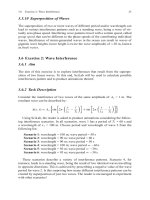
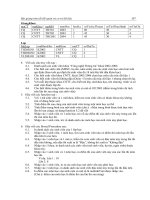

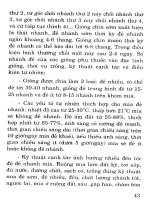
![[HeadWay] Phrasal Verbs and Idioms - Oxford University phần 10 potx](https://media.store123doc.com/images/document/2014_07/13/medium_hxp1405243210.jpg)
